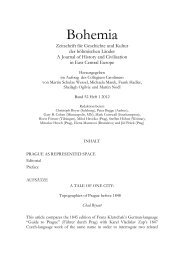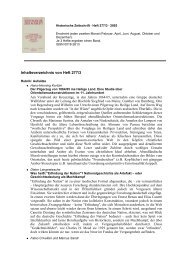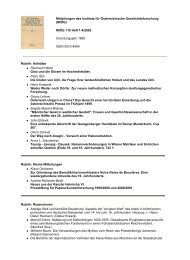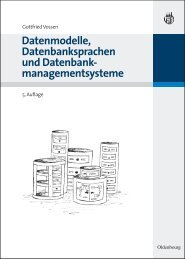Electrochemical Micromachining of Stainless Steel by Ultrashort ...
Electrochemical Micromachining of Stainless Steel by Ultrashort ...
Electrochemical Micromachining of Stainless Steel by Ultrashort ...
Create successful ePaper yourself
Turn your PDF publications into a flip-book with our unique Google optimized e-Paper software.
Z. Phys. Chem. 217 (2003) 299–313<br />
© <strong>by</strong> Oldenbourg Wissenschaftsverlag, München<br />
<strong>Electrochemical</strong> <strong>Micromachining</strong> <strong>of</strong> <strong>Stainless</strong><br />
<strong>Steel</strong> <strong>by</strong> <strong>Ultrashort</strong> Voltage Pulses<br />
By Laurent Cagnon 1 , Viola Kirchner 1 , Matthias Kock 1 , Rolf Schuster 1 , ∗ ,<br />
Gerhard Ertl 1 , W. Thomas Gmelin 2 , and Heinz Kück 2<br />
1 Fritz-Haber-Institut der Max-Planck-Gesellschaft, 14195 Berlin, Germany<br />
2 IZFM, Universität Stuttgart, 70174 Stuttgart, Germany<br />
Dedicated to Pr<strong>of</strong>. Dr. Dieter M. Kolb on the occasion<br />
<strong>of</strong> his 60 th birthday<br />
(Received and accepted July 15, 2002)<br />
<strong>Stainless</strong> <strong>Steel</strong> / Microstructures / Micr<strong>of</strong>abrication / Electrochemistry /<br />
Short Voltage Pulses<br />
Application <strong>of</strong> ultrashort voltage pulses to a tiny tool electrode under suitable electrochemical<br />
conditions enables precise three-dimensional machining <strong>of</strong> stainless steel.<br />
In order to reach submicrometer precision and high processing speed, the formation<br />
<strong>of</strong> a passive layer on the workpiece surface during the machining process has to be<br />
prevented <strong>by</strong> proper choice <strong>of</strong> the electrolyte. Mixtures <strong>of</strong> concentrated hydr<strong>of</strong>luoric and<br />
hydrochloric acid are well suited in this respect and allow the automated machining <strong>of</strong><br />
complicated three-dimensional microelements. The dependence <strong>of</strong> the machining precision<br />
on pulse duration and pulse amplitude was investigated in detail.<br />
1. Introduction<br />
The progress <strong>of</strong> modern electronics technology towards smaller devices triggered<br />
the miniaturization <strong>of</strong> mechanical and optical parts and components<br />
like sensors, connectors, actuators or reactors [1–6]. Besides semiconductors,<br />
metals become increasingly important to fulfill the specifications <strong>of</strong> such<br />
applications. Molding techniques for the mass production <strong>of</strong> plastic microcomponents<br />
[7] require the fabrication <strong>of</strong> molds from hard materials, preferentially<br />
alloyed steels. However, methods which allow for the three-dimensional micromachining<br />
<strong>of</strong> metals are rather limited. Although conventional mechanical<br />
methods like milling or electrical discharge machining were steadily improved,<br />
* Corresponding author: E-mail: schuster@fhi-berlin.mpg.de
300 L. Cagnon et al.<br />
in the lower micrometer to nanometer range only very restricted techniques are<br />
available [8]. Particularly electrochemical techniques became valuable tools<br />
for the fabrication <strong>of</strong> microelements, which benefit from the absence <strong>of</strong> mechanical<br />
or thermal stress, induced <strong>by</strong> most machining methods like milling or<br />
laser ablation. For example the LIGA process belongs into this category where<br />
<strong>by</strong> a combination <strong>of</strong> lithographic techniques and electrochemical metal deposition<br />
small, essentially two-dimensional structures can be produced [9]. Also<br />
partial isolation <strong>of</strong> the electrodes <strong>by</strong> patterned masks is employed [10, 11], e.g.,<br />
for the etching <strong>of</strong> small nozzles for ink jet printers.<br />
The various electrochemical microstructuring methods can be separated<br />
into two groups. In the ‘top down’ approach the electrochemical reactions<br />
are localized on the workpiece surface <strong>by</strong> employing geometrical constraints.<br />
Macroscopic amounts <strong>of</strong> material are removed in parallel and the shape <strong>of</strong> the<br />
tool electrode or the pattern <strong>of</strong> a mask is directly imprinted onto the workpiece.<br />
On the other hand, in the ‘bottom up’ approach small amounts <strong>of</strong> material<br />
are sequentially manipulated and the desired structure is built up from small<br />
entities like clusters consisting <strong>of</strong> only a few atoms. The combination <strong>of</strong> electrochemical<br />
techniques with scanning probe microscopy provides a fascinating<br />
tool on such atomic scale. The most prominent electrochemical method in<br />
this respect certainly is the local, mechanical deposition <strong>of</strong> small metal clusters<br />
<strong>of</strong> only a few hundred atoms with a tiny STM tip, where the metal was<br />
previously electrochemically deposited, developed in Kolb’s group at the University<br />
<strong>of</strong> Ulm. The precise deposition <strong>of</strong> arrays <strong>of</strong> thousands <strong>of</strong> clusters was<br />
impressively demonstrated [12, 13]. Other methods include local deposition<br />
<strong>of</strong> small Co clusters <strong>by</strong> electrochemical redissolution from an STM tip [14]<br />
and the local Ag, Pt or Cu cluster deposition on graphite [15, 16] or Au surfaces<br />
[17, 18] <strong>by</strong> local nucleation in small holes, previously formed <strong>by</strong> voltage<br />
pulses to an STM tip. Similarly, atomic steps on a single crystalline surface<br />
were used as nucleation sites for the electrochemical deposition <strong>of</strong> metallic<br />
nanowires [19].<br />
Although these ‘bottom up’ methods allow for the precise manipulation<br />
on almost atomic scale, their use for the machining <strong>of</strong> complicated three dimensional<br />
structures on the micrometer scale seems rather restricted, as long<br />
as they suffer from slow machining speed and specialized materials. On the<br />
other hand most electrochemical ‘top down’ methods have to circumvent the<br />
problem <strong>of</strong> weak spatial resolution <strong>of</strong> conventional electrochemistry: Upon polarization<br />
<strong>of</strong> electrodes immersed into an electrolyte the applied potential drops<br />
mainly in the electrochemical double layers on the electrode’s surfaces, which<br />
reach only a few water layers deep into solution. Since the rates <strong>of</strong> the electrochemical<br />
reactions are governed <strong>by</strong> the potential drop in the double layer (DL),<br />
the shape and position <strong>of</strong> the counter electrode are only <strong>of</strong> secondary influence<br />
on the reactions on the electrodes’ surfaces.<br />
An <strong>of</strong>ten-applied solution to locally influence the reaction rates at a workpiece<br />
is to manipulate the density <strong>of</strong> the Faradaic current, passing through
<strong>Electrochemical</strong> <strong>Micromachining</strong> <strong>of</strong> <strong>Stainless</strong> <strong>Steel</strong> <strong>by</strong> <strong>Ultrashort</strong> Voltage Pulses 301<br />
the electrolyte. This is performed in two ways, either <strong>by</strong> local insulation <strong>of</strong><br />
one or both <strong>of</strong> the electrodes [20, 21] or <strong>by</strong> making use <strong>of</strong> the ohmic potential<br />
drop in the electrolyte due to high Faradaic currents at high overpotentials.<br />
Both methods exist in various sophisticated modifications. Recently<br />
the spatial resolution <strong>of</strong> conventional electrochemical countersinking, where<br />
DC voltages <strong>of</strong> up to 40 V are applied to the electrodes, has been improved<br />
down to the 10 µm range <strong>by</strong> reducing the gap width between the negatively<br />
shaped tool electrode and the workpiece. To supply fresh electrolyte and to<br />
remove dissolved material from the gap, it is cyclically opened, after switching<br />
<strong>of</strong>f the cell voltage [22]. Small holes with diameters down to about 10 µm,<br />
e.g., in turbine blades or injection nozzles, were electrochemically drilled<br />
with small electrolyte-filled glass capillaries, where the electrochemical reactions<br />
are confined close to the orifice <strong>of</strong> the capillary [23]. Even higher<br />
spatial resolution, although restricted to the fabrication <strong>of</strong> shallow indents, was<br />
achieved with the help <strong>of</strong> ultramicroelectrodes in the scanning electrochemical<br />
microscope [24–26]. Holes in thin metal films were produced <strong>by</strong> through<br />
mask etching, and the inverse process, the electrochemical deposition, e.g., <strong>of</strong><br />
Cu and Ni into patterned masks is employed in the LIGA process for the mass<br />
production <strong>of</strong> metallic microelements with precisions better than 100 nm and<br />
a thickness up to several hundred micrometers. However, although obtaining<br />
highest precision, close to that obtained with ‘bottom up’ techniques, all mask<br />
techniques allow basically only for the fabrication <strong>of</strong> two-dimensional structures.<br />
Inclined walls or three-dimensional structures are difficult, if not even<br />
impossible, to be fabricated with these methods.<br />
Recently we introduced a different approach, where electrochemical reactions<br />
are spatially confined with down to nanometer precision through the<br />
application <strong>of</strong> ultrashort voltage pulses [27, 28]. This technique may help to<br />
bridge the gap between the versatility <strong>of</strong> the ‘top down’ and the precision <strong>of</strong> the<br />
‘bottom up’ methods for three dimensional electrochemical microstructures.<br />
With this method, the electrochemical reaction rates on the workpiece surface<br />
are directly controlled <strong>by</strong> local polarization <strong>of</strong> the double layer. It employs the<br />
finite time constant for the polarization <strong>of</strong> the double layer (DL) upon a voltage<br />
pulse. This time constant is given <strong>by</strong> the product <strong>of</strong> the electrolyte resistance<br />
along the current path and the double layer capacitance, and therefore varies<br />
linearly with the separation between the electrodes. By application <strong>of</strong> ultrashort<br />
voltage pulses between a workpiece and a tiny tool electrode, the DL at the<br />
workpiece is only noticeably charged, where both electrodes are in close proximity,<br />
i.e., where the electrolyte resistance along the current path is low enough<br />
to allow significant flow <strong>of</strong> charging current. Since the rate <strong>of</strong> electrochemical<br />
reactions is exponentially dependent on the voltage drop in the DL, the reaction<br />
at the workpiece is strongly confined to the charged region. As described in detail<br />
in Ref. [27] and Section 4, assuming typical DL capacitance and specific<br />
electrolyte resistance, pulses <strong>of</strong> a couple <strong>of</strong> 10 ns duration confine the charging<br />
<strong>of</strong> the DL to areas on the electrode surfaces, where the distance between
302 L. Cagnon et al.<br />
Fig. 1. Pyramid, etched into a stainless steel sheet with the electrochemical pulse method.<br />
A conically shaped W wire with less than 5 µm diameter was moved similar to a miniature<br />
milling cutter. Etched with 25 ns/2 V pulses in 3 M HCl/6M HF (Φ wp =−200 mV Pd/H,<br />
Φ tool =−100 mV Pd/H).<br />
the tool and the workpiece electrode amounts to less than a few micrometers.<br />
We achieved a machining precision <strong>of</strong> about 200 nm for the etching <strong>of</strong> stainless<br />
steel <strong>by</strong> 5 ns pulses as discussed later.<br />
During etching with short voltage pulses the tool electrode can be molded<br />
precisely into the workpiece. Additionally, <strong>by</strong> moving the tool in three dimensions<br />
similar to a miniature milling cutter, individual three-dimensional<br />
microstructures can be machined from any electrochemically active material.<br />
The method has been successfully demonstrated for the micromachining <strong>of</strong><br />
metals, alloys and semiconductors. In this paper we present results on the machining<br />
<strong>of</strong> stainless steel. The mechanical strength and chemical resistance <strong>of</strong><br />
stainless steel can be widely varied <strong>by</strong> adjusting the alloy composition. Therefore,<br />
stainless steel is one <strong>of</strong> the most widely used construction material for<br />
applications ranging from chemical plants to chirurgical microtools. Its resistance<br />
against corrosion imposes special requirements on the composition <strong>of</strong><br />
the electrolyte to prevent passivation <strong>of</strong> the workpiece during the electrochemical<br />
machining process. In detail the etching <strong>of</strong> the highly alloyed austenitic<br />
1.4301 steel in acidic and highly concentrated halogenide electrolytes will be<br />
presented. It is demonstrated how machining rate, spatial resolution and surface<br />
quality can be controlled.<br />
Fig. 1 shows a small pyramid, machined directly into a stainless steel sheet<br />
with a thin conical tungsten tip, whose tip angle defined the slope <strong>of</strong> the pyramid’s<br />
faces. The structure <strong>of</strong> the pyramid is well defined on micrometer scale<br />
with sharp edges with radii <strong>of</strong> curvature smaller than 1 µm. The etched faces<br />
show a roughness in the submicrometer range, whereas the surface around the<br />
structure still exhibits the original morphology <strong>of</strong> the sheet with the scratches
<strong>Electrochemical</strong> <strong>Micromachining</strong> <strong>of</strong> <strong>Stainless</strong> <strong>Steel</strong> <strong>by</strong> <strong>Ultrashort</strong> Voltage Pulses 303<br />
from polishing still visible. This indicates the strong localization <strong>of</strong> the electrochemical<br />
reactions due to the exponential decay <strong>of</strong> the etching rate with<br />
increasing distance.<br />
The pyramid was laid open <strong>by</strong> etching a stainless steel sheet in 3 M HCl/<br />
6 M HF electrolyte <strong>by</strong> 25 ns short voltage pulses (2 V amplitude, average potential<br />
<strong>of</strong> the workpiece Φ wp =−200 mV Pd/H, and tool Φ tool =−100 mV Pd/H).<br />
Concentrated acidic, halogenide-ions containing solutions are very well suited<br />
to overcome the passivation <strong>of</strong> the stainless steel surface against corrosion and<br />
to allow for successful electrochemical machining. The proper choice <strong>of</strong> the<br />
electrolyte’s composition and the determination <strong>of</strong> the average potentials <strong>of</strong> the<br />
electrodes are discussed in detail in Section 3. In Section 4 the influence <strong>of</strong> the<br />
machining parameters like pulse duration and amplitude on the spatial resolution<br />
is investigated and compared with theoretical predictions. Experimental<br />
details are described in Section 2.<br />
2. Experimental<br />
The experimental setup comprises the control <strong>of</strong> the potentials <strong>of</strong> workpiece<br />
and tool, the electronics for providing the nanosecond voltage pulses, and<br />
features for the three dimensional manipulation <strong>of</strong> the tool electrode. The<br />
workpiece was immersed in an electrochemical cell mounted on a piezodriven<br />
x-y-z stage, which was equipped with strain gauges (Tritor 3D 100 NV,<br />
Piezosystem Jena) and allowed the control <strong>of</strong> the absolute position <strong>of</strong> the workpiece<br />
with respect to the tool electrode with an accuracy better than 0.1 µm.<br />
As samples we used 0.1 mm thin sheets <strong>of</strong> austenitic 1.4301 stainless steel<br />
which contains 18% Cr and 9% Ni. They were mechanically ground and polished<br />
with diamond paste down to 3 µm grain size. The tool electrodes were<br />
prepared from thin wires <strong>of</strong> either Pt or W. Cylindrically shaped tools were<br />
fabricated from Platinum wire, 50 µm in diameter, whose front face was mechanically<br />
ground and polished with Si-C and Al 2O 3 paper. During polishing the<br />
wire was embedded into a dissolvable resin for stability. Thinner and mechanically<br />
more stable tool electrodes were electrochemically etched from tungsten<br />
wires in 2 M KOH with a loop <strong>of</strong> a gold wire serving as counter electrode,<br />
similar to the fabrication <strong>of</strong> STM tips [29]. To reduce electrochemical currents<br />
during the machining experiments, the upper shafts <strong>of</strong> the tools were electrically<br />
insolated with a thermoplastic wax (Apiezon W).<br />
The average potential <strong>of</strong> workpiece (Φ wp) and tool electrode (Φ tool) were<br />
controlled separately <strong>by</strong> a bipotentiostat [30]. Low-pass filters at its inputs<br />
suppress the high frequency components. The potentials were adjusted <strong>by</strong><br />
a Pt counter electrode (CE) versus a palladium wire saturated with hydrogen<br />
(Pd/H), which served as reference electrode (RE). The wire was prepared prior<br />
to the machining experiment <strong>by</strong> electrochemical hydrogen evolution in diluted<br />
sulfuric acid for at least 20 minutes.
304 L. Cagnon et al.<br />
Trains <strong>of</strong> rectangular voltage pulses with a pulse to pause ratio <strong>of</strong> 1:10<br />
generated <strong>by</strong> a high frequency pulse generator were applied between tool and<br />
workpiece. To match the impedance <strong>of</strong> the high frequency cables with that <strong>of</strong><br />
the electrochemical cell, a high-speed buffer amplifier was mounted close to<br />
the tool electrode. The high frequency cell current and the pulse shape at the<br />
tool electrode were monitored with a real-time oscilloscope. Amplitude and<br />
shape <strong>of</strong> the cell current transient reflect directly the charging behavior <strong>of</strong> the<br />
double layer, i.e., the actual distance between tool and workpiece [27], and<br />
were used to in-situ check the machining process.<br />
The motion <strong>of</strong> the tool during the machining process was computer controlled.<br />
Occurrence <strong>of</strong> electric shortcuts between tool and workpiece electrodes,<br />
signaling too high feeding rates, was used to adjust the feeding rate <strong>of</strong><br />
the tool. Immediately after a contact was detected the wire was retracted along<br />
the milling path until the contact was released. Subsequently the tool was fed<br />
again in the forward direction. Additionally, this back- and forward movement<br />
flushes the electrolyte and enforces the removal <strong>of</strong> dissolved material from the<br />
narrow gap between the two electrodes. The maximum feeding rate achieved in<br />
our experiments is dependent on the machining parameters. For the conditions<br />
<strong>of</strong> Fig. 1, lateral feeding rates <strong>of</strong> about 1 µm/s were achieved.<br />
3. <strong>Electrochemical</strong> conditions for stainless steel<br />
micromachining<br />
Prerequisite for the electrochemical micromachining with ultrashort voltage<br />
pulses is fast and homogeneous electrochemical dissolution <strong>of</strong> the workpiece<br />
in direct vicinity <strong>of</strong> the tool electrode. However, it is just the characteristic<br />
<strong>of</strong> stainless steel that it is resistant against corrosion even upon application <strong>of</strong><br />
moderate potentials, where its constituents should be dissolved from the thermodynamic<br />
point <strong>of</strong> view [31]. In this so-called passive region practically no<br />
electrochemical current is flowing, due to the formation <strong>of</strong> a passive layer.<br />
Metal atoms <strong>of</strong> the alloy are oxidized to hydroxides and oxides and form an<br />
only few nanometers thick, but dense film on the surface. High Cr and Ni<br />
contents in the alloy stabilize this film, which inhibits further oxidation and<br />
dissolution <strong>of</strong> the material. Only at very positive potentials, in the so-called<br />
transpassive region, ion transport in the passive layer sets in and the steel is anodically<br />
dissolved accompanied <strong>by</strong> oxygen evolution. For 1.4301 stainless steel<br />
in 3 M HCl/6 M HF electrolyte, the passivation peak can be found at around<br />
+0.2V Pd/H and the passive region extends to about +1.5V Pd/H.<br />
Halogenide ions are known to chemically destabilize the passive layer. In<br />
the presence <strong>of</strong> Cl − ions the dissolution <strong>of</strong> most stainless steels starts already<br />
in the passive region <strong>by</strong> the local formation <strong>of</strong> etch pits [32], one <strong>of</strong> the major<br />
reasons for corrosion problems caused <strong>by</strong> sea water or in chemical plants.<br />
On the other hand, technical processes exploit the weakening <strong>of</strong> the passive<br />
layer <strong>by</strong> halogenides. E.g., in conventional electrochemical machining highly
<strong>Electrochemical</strong> <strong>Micromachining</strong> <strong>of</strong> <strong>Stainless</strong> <strong>Steel</strong> <strong>by</strong> <strong>Ultrashort</strong> Voltage Pulses 305<br />
Fig. 2. Oxide flitters peeling <strong>of</strong>f the surface <strong>of</strong> a hole machined in 1 M HCl with<br />
500 ns/2 V pulses.<br />
concentrated NaCl electrolytes are used for fast dissolution <strong>of</strong> stainless steel.<br />
Typically, the process is conducted in the transpassive region and voltages <strong>of</strong><br />
10 to 40 V (DC or low frequency AC) are applied between tool and workpiece<br />
[33].<br />
It seems to be straightforward to use Cl − containing electrolytes also for<br />
the electrochemical micromachining with ultrashort voltage pulses. Therefore,<br />
in first experiments we used 1 M HCl as electrolyte. The average potential <strong>of</strong><br />
the workpiece was adjusted to the so-called active region <strong>of</strong> the surface, where<br />
the passive layer is not yet formed. However, upon application <strong>of</strong> pulses with<br />
up to 3 V amplitude and pulse durations between 50 ns and 500 ns the etching<br />
usually stopped after penetrating a few micrometers into the surface. Although<br />
no electrical contact could be detected, further feed <strong>of</strong> the tool was impossible<br />
without mechanical deformation. Inspection <strong>of</strong> the etched holes typically<br />
showed the formation <strong>of</strong> a film, which eventually peels <strong>of</strong>f the surface (Fig. 2).<br />
We interpret these as flitters <strong>of</strong> a thick oxide film, which were electrochemically<br />
formed at the steel surface and which grew mechanically unstable due to<br />
their increasing thickness with progressing oxidation. These loose oxide flitters<br />
effectively insulate the workpiece surface and the electrochemical machining<br />
stops. In conventional electrochemical machining, where the distance between<br />
the electrodes is rather in the 100 µm to mm range, they are just underetched<br />
and form the so-called anode mud, which is usually rinsed away <strong>by</strong> agitation <strong>of</strong><br />
the electrolyte. However, in electrochemical micromachining the size <strong>of</strong> these<br />
oxide flitters exceeds the gap width between the electrodes and therefore hinders<br />
the etching. Machining with high pulse voltages up to 20 V, i.e., working<br />
in the transpassive region <strong>of</strong> the stainless steel dissolution, did not reliably<br />
solve the problem. In addition, the tiny tool electrodes <strong>of</strong>ten were destroyed <strong>by</strong><br />
such high voltages.<br />
It turned out that the formation <strong>of</strong> a thick oxide layer could be chemically<br />
prevented <strong>by</strong> employing more ‘aggressive’ electrolytes. With an aqueous so-
306 L. Cagnon et al.<br />
Fig. 3. Comparison <strong>of</strong> holes drilled into stainless steel in different electrolytes (Tool:<br />
cylindrical Pt wire <strong>of</strong> 50 µm diameter; pulses: 50 ns/2V; Φ wp ≈−100 mV Pd/H, Φ tool ≈<br />
100 mV Pd/H).<br />
lution <strong>of</strong> 3 M HCl and 6 M HF we found an electrolyte mixture which allows<br />
the precise electrochemical etching and very fast micromachining <strong>of</strong> 1.4301<br />
stainless steel (Fig. 1, Fig. 3a). Pulse amplitudes <strong>of</strong> only 1.5 to 2 V allowed<br />
machining rates up to several micrometers per second. On the other hand, <strong>by</strong><br />
proper adjustment <strong>of</strong> the average surface potential to about −200 mV Pd/H, significant<br />
overall corrosion <strong>of</strong> the surface could be avoided for several hours.<br />
In order to check the influence <strong>of</strong> the different ions in the mixture <strong>of</strong><br />
hydrochloric and hydr<strong>of</strong>luoric acid we performed several experiments with different<br />
electrolytes (Fig. 3). A flattened, cylindrical 50 µm Pt-wire served as<br />
tool electrode in these experiments and was etched into the surface with 50 ns,<br />
2 V pulses. High acidity <strong>of</strong> the electrolyte seems to be an important precondition<br />
for successful micromachining. Upon increasing the pH to about pH 3
<strong>Electrochemical</strong> <strong>Micromachining</strong> <strong>of</strong> <strong>Stainless</strong> <strong>Steel</strong> <strong>by</strong> <strong>Ultrashort</strong> Voltage Pulses 307<br />
and leaving the halogenide ion content constant <strong>by</strong> substituting HCl <strong>by</strong> KCl<br />
(3 M KCl/6 M HF), the etching almost ceased and the feeding rate <strong>of</strong> the<br />
tool became very low. The etched structures exhibited a porous bottom, which<br />
might be indicative <strong>of</strong> pit formation due to the high Cl − content (Fig. 3c). Indeed,<br />
in pure 6 M HF (Fig. 3d) the etching produced rather smooth surfaces,<br />
although proceeding very slowly. The necessary fluoride content is strongly<br />
dependent on the HCl concentration. In 3 M HCl electrolytes the HF concentration<br />
could be reduced from 6 M to 1.2 M without degrading the machining<br />
process (Fig. 3b). However, in 1 M HCl/1.2 M HF micromachining was almost<br />
impossible (Fig. 3e). In pure 3 M HCl (Fig. 3f) etching proceeds very slowly<br />
and irreproducibly. However, increasing the HCl concentration to about 5 M<br />
enables the machining even in the absence <strong>of</strong> fluoride. In halogenide free acids<br />
such as sulfuric acid the electrochemical micromachining <strong>of</strong> stainless steel did<br />
not succeed. We conclude that the presence <strong>of</strong> high concentrations <strong>of</strong> halogenide<br />
ions together with a low pH chemically prevents the formation <strong>of</strong> thick<br />
oxide films on the stainless steel surface under our machining conditions.<br />
It should be mentioned at this point that also the presence <strong>of</strong> complexing<br />
agents might prevent the formation <strong>of</strong> thick oxide layers. First experiments in<br />
saturated KCl electrolyte with 2.7 M citric acid showed promising results. By<br />
application <strong>of</strong> 1.5 to 4 V pulses (100 to 200 ns) 10 µm deep holes could be<br />
etched within about 5 minutes. The machining rate was more than an order<br />
<strong>of</strong> magnitude slower than for 3 M HCl/6 M HF and the process was rather<br />
sensitive towards accidental shortcuts between the electrodes upon which the<br />
surface became irreversibly passivated. Further studies on such less toxic and<br />
aggressive electrolytes are in progress.<br />
In addition to the chemical composition <strong>of</strong> the electrolyte, the electrochemical<br />
parameters like the average potentials <strong>of</strong> workpiece and tool electrodes<br />
and the pulse amplitude are <strong>of</strong> equal importance for successful machining.<br />
The overall corrosion <strong>of</strong> both, workpiece and tool has to be avoided, which<br />
would favor potentials as negative as possible. However, too strong hydrogen<br />
evolution at tool or workpiece displaces the electrolyte from the electrode surfaces<br />
and therefore hinders the electrochemical machining. On the other hand,<br />
it turned out that moderate hydrogen evolution, which takes place at the tool<br />
electrode as local counter reaction to the local dissolution <strong>of</strong> the workpiece, effectively<br />
agitates the electrolyte and helps to remove debris from the machining<br />
region. For the electrolyte mostly used in this study for the machining <strong>of</strong> stainless<br />
steel, 3 M HCl/6 M HF, the workpiece surface was stable for several hours<br />
without significant corrosion at average potentials near −200 mV Pd/H. Atthis<br />
potential the surface is not covered <strong>by</strong> a passive layer, which turned out to be<br />
a prerequisite for the machining <strong>of</strong> stainless steel in HCl/HF electrolytes. If<br />
the average potential <strong>of</strong> the workpiece is held in the passive region, no etching<br />
with short pulses is possible, not even if the pulses polarize the surface<br />
into the transpassive region. Probably, ion transport through the passive layer<br />
is occurring on a time scale much longer than the pulse duration.
308 L. Cagnon et al.<br />
Fig. 4. Holes drilled into stainless steel with different pulse amplitudes employing the<br />
same cylindrical tool (50 µm diameter). 1.5 V pulses yielded sharp structures with micro<br />
porous surfaces. With 4 V pulse amplitude electropolished surfaces were achieved (Pulse<br />
duration: 50 ns; 3 M HCl/6MHF;Φ wp =−120 mV Pd/H, Φ tool = 80 mV Pd/H).<br />
Starting from the active potential region the applied pulse amplitude had<br />
to exceed about 1.5 V to dissolve the steel properly. Because the double layers<br />
<strong>of</strong> both, tool and workpiece are charged upon application <strong>of</strong> a voltage pulse,<br />
the pulse amplitude is shared between these two capacitances. Therefore, the<br />
polarization <strong>of</strong> the workpiece double layer during a pulse amounts roughly to<br />
about half the pulse amplitude. A typical pulse amplitude <strong>of</strong> 1.5 V, starting<br />
from an average potential <strong>of</strong> about −200 mV Pd/H, will achieve a local polarization<br />
<strong>of</strong> the workpiece corresponding to potentials in the passive region.<br />
However, due to the short pulse duration <strong>of</strong> only nanoseconds no dense passive<br />
layer is formed, since otherwise we could not machine the surface. This<br />
demonstrates that data obtained with conventional cyclic voltammetry with<br />
scan rates <strong>of</strong> typically 50 mV/s cannot directly be transferred to processes on<br />
nanosecond timescale. The absence <strong>of</strong> passivation in our experiment is conceivable,<br />
considering that even at the highest machining rates the material<br />
removal per pulse amounts only to about one hundreds <strong>of</strong> a monolayer. In contrast<br />
the thickness <strong>of</strong> the passive layer amounts to several nanometers [31].<br />
The pulse amplitude also influences the surface quality (Fig. 4). Whereas<br />
with 1.5 V pulses the surface <strong>of</strong> the machined hole exhibits roughness on submicrometer<br />
scale, for 4 V pulses the machined surface appears smooth and the<br />
grain structure <strong>of</strong> the stainless steel sheet becomes visible. This is similar to DC<br />
machining <strong>of</strong> stainless steel, where the application <strong>of</strong> higher cell voltages also<br />
leads to electropolishing <strong>of</strong> the surface.<br />
4. Spatial resolution<br />
The method exploits a general characteristic <strong>of</strong> electrochemical systems. As<br />
mentioned above electrochemical reactions are governed <strong>by</strong> the potential drop<br />
in the electrochemical double layer at the interface <strong>of</strong> an electrode with the<br />
electrolyte. This double layer (DL), consisting <strong>of</strong> ions in front <strong>of</strong> the electrode<br />
and the corresponding influenced charge <strong>of</strong> opposite sign on the electrode’s<br />
surface constitutes a plate capacitor with a specific capacitance c DL. Upon
<strong>Electrochemical</strong> <strong>Micromachining</strong> <strong>of</strong> <strong>Stainless</strong> <strong>Steel</strong> <strong>by</strong> <strong>Ultrashort</strong> Voltage Pulses 309<br />
application <strong>of</strong> a voltage step between two electrodes the double layer capacitances<br />
are charged <strong>by</strong> a capacitive current flowing through the electrolyte with<br />
a finite specific resistance ρ. Therefore, the voltage drop in the DL follows<br />
an exponential time law with a charging time constant τ, given <strong>by</strong> the product<br />
<strong>of</strong> double layer capacitance C and local electrolyte resistance R along<br />
the current path. For a one-dimensional case the latter is proportional to the<br />
local distance d between the electrodes and the specific electrolyte resistance<br />
ρ: τ = RC = ρ c DLd. Here the idea <strong>of</strong> ultrashort voltage pulses comes into play.<br />
Switching the voltage <strong>of</strong>f after a short time t allows for significant charging<br />
<strong>of</strong> the DL only, where the local time constant τ becomes shorter or equal to t.<br />
Since electrochemical reaction rates are in general exponentially dependent on<br />
the polarization <strong>of</strong> the DL, reactions like the dissolution <strong>of</strong> the workpiece are<br />
strongly confined to electrode areas, where the DL is significantly charged, i.e.,<br />
where the electrodes are in very close proximity.<br />
The above formula readily implies that the shorter the pulses are, the<br />
smaller the separation <strong>of</strong> the electrodes has to be for significant charging <strong>of</strong><br />
the DL. In particular the distance between the electrodes up to which the electrochemical<br />
reactions take place with a significant rate <strong>of</strong> removal <strong>of</strong> material,<br />
which is equivalent to the spatial resolution <strong>of</strong> the method, is expected to vary<br />
linearly with the pulse duration. This has been previously demonstrated for the<br />
machining <strong>of</strong> Cu [27] and is shown in the following within a slightly different<br />
experiment for the machining <strong>of</strong> stainless steel. For this purpose a cylindrical<br />
tool electrode was positioned 0.5 µm in front <strong>of</strong> the stainless steel surface.<br />
In subsequent experiments pulses with durations between 7 ns and 200 ns and<br />
pulse to pause ratios <strong>of</strong> 1:10 were applied for 5 min. The width <strong>of</strong> the gap between<br />
the face <strong>of</strong> the tool and the bottom <strong>of</strong> the resulting holes is plotted in<br />
Fig. 5 versus the pulse duration. Particularly for small pulse durations, the gap<br />
width, i.e. the spatial resolution, scales linearly, as indicated <strong>by</strong> the line. For<br />
longer pulse durations probably mass transport limitations lower the rate <strong>of</strong><br />
material removal and therefore the achieved depth <strong>of</strong> the hole.<br />
The above relation for the time constant provides a rough estimate for the<br />
spatial resolution <strong>of</strong> the method, since the local distance d between the electrodes<br />
can be considered as measure for the spatial resolution. The local time<br />
constant for double layer charging, determined <strong>by</strong> the local distance <strong>of</strong> the<br />
electrodes d, should amount to less or equal the pulse duration. To match the<br />
experimental conditions we assume an specific electrolyte resistance <strong>of</strong> 2 Ω cm<br />
and a typical DL capacitance <strong>of</strong> 10 µF/cm 2 . Solving the equation for d for<br />
a pulse duration <strong>of</strong> 50 ns leads to an expected resolution <strong>of</strong> about 25 µm. This is<br />
significantly larger than the observed spatial resolution for the same pulse duration<br />
in Fig. 5. However, the above approximation completely disregards the<br />
absolute amount <strong>of</strong> the electrochemical reaction rate, which together with the<br />
machining time determines the amount <strong>of</strong> dissolved material during the experiment.<br />
A crucial experimental parameter in this respect is the pulse amplitude<br />
which determines the maximum achievable machining rate. This is demon-
310 L. Cagnon et al.<br />
gap width [µm]<br />
10<br />
8<br />
6<br />
4<br />
2<br />
0<br />
0<br />
50<br />
100<br />
pulse duration [ns]<br />
Fig. 5. Spatial resolution versus pulse duration. The gap width under the face <strong>of</strong> a 50 µm<br />
diameter cylindrical tool was determined for different pulse durations. The tool was positioned<br />
0.5 µm above the stainless steel surface and pulses with 1.6 V amplitude were<br />
applied for 5 minutes (3 M HCl/6MHF;Φ wp =−270 mV Pd/H, Φ tool =−370 mV Pd/H).<br />
Fig. 6. Array <strong>of</strong> holes drilled with different pulse parameters into stainless steel. The<br />
diameter <strong>of</strong> the holes increases with both, the pulse duration and the amplitude (Tool:<br />
cylindrical Pt wire with 50 µm diameter; 3 M HCl/6MHF;Φ wp =−120 mV Pd/H, Φ tool =<br />
80 mV Pd/H).<br />
strated in Fig. 6, which shows an array <strong>of</strong> holes machined into a stainless steel<br />
sheet <strong>by</strong> a cylindrical 50 µm diameter tool with different pulse amplitudes and<br />
durations. Comparison <strong>of</strong> the holes at constant pulse durations clearly shows<br />
that upon increasing the pulse duration also the hole diameter increases, i.e.,<br />
the spatial resolution decreases. This is conceivable considering that upon increasing<br />
the pulse amplitude, the distance between the electrodes where the<br />
150<br />
200
<strong>Electrochemical</strong> <strong>Micromachining</strong> <strong>of</strong> <strong>Stainless</strong> <strong>Steel</strong> <strong>by</strong> <strong>Ultrashort</strong> Voltage Pulses 311<br />
Fig. 7. Detail <strong>of</strong> a stainless steel structure, etched with 5 ns/1.8 V pulses. The surface<br />
roughness is well below 200 nm. Radii <strong>of</strong> curvature below 0.5 µm were obtained<br />
(Tool:bentWwirewith3µm diameter; 3 M HCl/6M HF; Φ wp =−150 mV Pd/H, Φ tool =<br />
−100 mV Pd/H).<br />
same polarization or machining rate as previously is reached, is also increasing.<br />
Quantitative evaluation <strong>of</strong> this experiment yielded a machining precision,<br />
i.e., gap width between the tool and the rime <strong>of</strong> the hole, <strong>of</strong>, for example, 5 µm<br />
for 1.5Vand15µm for 4 V pulses at 50 ns pulse duration.<br />
In conclusion, the careful adjustment <strong>of</strong> pulse amplitude and pulse duration<br />
allows for machining precision in the submicrometer range, although<br />
the passivation behavior <strong>of</strong> stainless steel necessitates the use <strong>of</strong> concentrated<br />
electrolytes. Fig. 7 demonstrates the high machining precision at the detail <strong>of</strong><br />
a structure machined with 5 ns pulse duration and 1.8 V pulse amplitude. The<br />
surface exhibits a roughness well below 200 nm and the radius <strong>of</strong> curvature at<br />
the edges reaches values below 500 nm. In principle further reduction <strong>of</strong> the<br />
pulse duration is expected to lead to further improvement <strong>of</strong> the machining precision.<br />
Considering the high electrolyte concentrations employed for stainless<br />
steel, the ion concentration in the small gap between the electrodes allows for<br />
charging <strong>of</strong> the double layer down to gap widths even below 10 nm [27]. With<br />
pulses in the 100 ps range, such machining resolutions seem to be within reach.<br />
5. Summary and perspective<br />
Proper choice <strong>of</strong> the electrolyte and careful adjustment <strong>of</strong> electrochemical<br />
and machining parameters allow for the machining <strong>of</strong> stainless steel with un-
312 L. Cagnon et al.<br />
Fig. 8. A prism, designed with a computer aided design (CAD) program was automatically<br />
etched into a stainless steel sheet. A fast rough cut with 143 ns pulses was followed <strong>by</strong><br />
a slow fine cut with 50 ns pulse duration (Tool: cylindrical W wire with 30 µm diameter;<br />
3MHCl/6MHF;Φ wp =−370 mV Pd/H, Φ tool =−200 mV Pd/H).<br />
precedented precision. The method works reliably and reproducibly, which<br />
is the prerequisite to etch complex structures and to automate the machining<br />
process. This was successfully achieved for the prism in Fig. 8. The 200 µm<br />
deep structure was machined with procedures similar to conventional milling.<br />
After the design <strong>of</strong> the structure with a commercial computer aided design<br />
(CAD) program, the path for the feed <strong>of</strong> the tool, a thin tungsten wire, was<br />
calculated. Afterwards the structure was etched in two steps: the ‘rough cut’<br />
was performed with 143 ns pulses and was followed <strong>by</strong> ‘fine etching’ with<br />
50 ns pulses. Contacts between tool and workpiece were in-situ monitored and<br />
the feed <strong>of</strong> the tool was correspondingly adjusted to avoid such events. The<br />
machining speed is given <strong>by</strong> the electrochemical dissolution rate <strong>of</strong> the stainless<br />
steel and <strong>by</strong> the mass transport in the gap between tool and workpiece.<br />
Therefore, the path and the movement <strong>of</strong> the tool during etching the workpiece<br />
are <strong>of</strong> crucial importance to achieve high machining speeds. To meet<br />
these challenges questions comprehensive and promising basic investigations<br />
on a suited automated microproduction technology based on electrochemical<br />
micromachining <strong>by</strong> ultrashort voltage pulses are currently performed at<br />
the IZFM.<br />
Acknowledgement<br />
The authors want to thank K. Weil and P. Allongue for fruitful discussions and<br />
comments. Technical support <strong>by</strong> G. Heyne and the members <strong>of</strong> the electronics<br />
laboratory <strong>of</strong> the FHI is gratefully acknowledged.
<strong>Electrochemical</strong> <strong>Micromachining</strong> <strong>of</strong> <strong>Stainless</strong> <strong>Steel</strong> <strong>by</strong> <strong>Ultrashort</strong> Voltage Pulses 313<br />
References<br />
1. I. Amato, Science 284 (1998) 402.<br />
2. H. G. Craighead, Science 290 (2000) 1532.<br />
3. W. Ehrfeld, V. Hessel, and H. Löwe, Microreactors – New Technology for Modern<br />
Chemistry, Wiley-VCH, Weinheim (2000).<br />
4. A. N. Cleland and M. L. Roukes, Nature 392 (1998) 160.<br />
5. S. Kawata, H.-B. Sun, T. Tanaka, and K. Takada, Nature 412 (2001) 697.<br />
6. K. Dunkel et al., J. Micromech. Microeng. 8 (1998) 301.<br />
7. W. Eberhardt et al.,inTransducers 01. The 11th International Conference on Solid-<br />
State Sensors and Actuators, Munich (2001).<br />
8. Handbook <strong>of</strong> Microlithography, <strong>Micromachining</strong>, and Micr<strong>of</strong>abrication. P. Rai-<br />
Choudhury, Ed. (SPIE Optical Engineering Press, Bellingham, WA, 1997), Vol. 1<br />
and 2.<br />
9. C. R. Friedrich, et al., inHandbook <strong>of</strong> Microlithography, <strong>Micromachining</strong>, & Micr<strong>of</strong>abrication.<br />
P. Rai-Choudhury, Ed., SPIE, Bellingham, WA (1997), Vol. 2,<br />
pp. 299–377.<br />
10. M. Datta and D. Harris, Electrochim. Acta 42 (1997) 3007.<br />
11. M. Datta and D. Landolt, Electrochim. Acta 45 (2000) 2535.<br />
12. D. M. Kolb, R. Ullmann, and T. Will, Science 275 (1997) 1097.<br />
13. G. E. Engelmann, J. C. Ziegler, and D. M. Kolb, Surface Sci. 401 (1998) L420.<br />
14. W. Schindler, D. H<strong>of</strong>mann, and J. Kirschner, J. Electrochem. Soc. 148 (2001) C124.<br />
15. W. Li, J. A. Virtanen, and R. M. Penner, Appl. Phys. Lett. 60 (1992) 1181.<br />
16. S. Gorer et al., Electrochim. Acta 43 (1999) 2799.<br />
17. R. Schuster, V. Kirchner, X. H. Xia, A. M. Bittner, and G. Ertl, Phys. Rev. Lett. 80<br />
(1998) 5599.<br />
18. X. H. Xia, R. Schuster, V. Kirchner, and G. Ertl, J. Electroanal. Chem. 461 (1999)<br />
102.<br />
19. M. P. Zach, K. H. Ng, and R. M. Penner, Science 290 (2000) 2120.<br />
20. C. Madore, O. Piotrowski, and D. Landolt, J. Electrochem. Soc. 146 (1990) 2526.<br />
21. E. Rosset, M. Datta, and D. Landolt, J. Appl. Electrochem. 20 (1990) 69.<br />
22. E. Uhlmann, U. Doll, R. Förster, R. Nase, and R. Schik<strong>of</strong>sky, Maschinenmarkt 45<br />
(2000) 34.<br />
23. A. Uhlir, Rev. Sci. Instrum. 26 (1955) 965.<br />
24. A. J. Bard and M. V. Mirkin, Eds., Scanning <strong>Electrochemical</strong> Microscopy, Marcel<br />
Dekker, Inc., New York (2001).<br />
25. A. J. Bard, G. Denault, C. Lee, D. Mandler, and D. O. Wipf, Acc. Chem. Res. 23<br />
(1990) 357.<br />
26. D. M. Mandler and A. J. Bard, J. Electrochem. Soc. 137 (1990) 1079.<br />
27. R. Schuster, V. Kirchner, P. Allongue, and G. Ertl, Science 289 (2000) 98.<br />
28. V. Kirchner, L. Cagnon, R. Schuster, and G. Ertl, Appl. Phys. Lett. 79 (2001) 1721.<br />
29. A. J. Melmed, J. Vac. Sci. Technol. B 9 (1991) 601.<br />
30. V. Kirchner, Ph.D. thesis, Freie Universität Berlin (2001).<br />
31. H. Kaesche, Metallic Corrosion Principles <strong>of</strong> Physical Chemistry and Current<br />
Problems, National Association <strong>of</strong> Corrosion Engineers (1985).<br />
32. H. H. Strehblow, Werkst. Korros. 35 (1984) 437.<br />
33. J. A. McGeough, Principles <strong>of</strong> <strong>Electrochemical</strong> Machining, Chapman and Hall,<br />
London (1974).
















